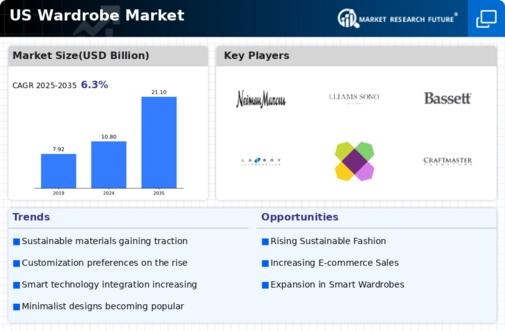The competitive insights of the US Wardrobe Market reveal a dynamic landscape characterized by evolving consumer preferences, innovative design trends, and strategic market positioning. With a diverse range of brands catering to various consumer segments, the market is fueled by a blend of luxury offerings and affordable options. The competition is not solely based on price but also on brand perception, quality, and the shopping experience. Retailers are increasingly focusing on enhancing customer engagement through omni-channel strategies, emphasizing both in-store experiences and online shopping functionalities. Sustainability and ethical sourcing are gaining prominence among consumers, influencing brand loyalty and purchasing decisions.
Players in the market continuously adapt to these shifting paradigms to maintain their competitive edge. Neiman Marcus stands out in the US Wardrobe Market due to its strong brand identity associated with luxury and high-quality offerings. Renowned for its curated collections that cater to affluent consumers, Neiman Marcus offers an upscale shopping experience emphasizing personalization and exceptional customer service. The company has bolstered its market presence through exclusive collaborations with renowned designers and brands, thereby cultivating a loyal customer base.
Furthermore, Neiman Marcus has invested in enhancing its e-commerce capabilities, making it easier for customers to access its premium products online. With its commitment to quality and an iconic brand reputation, Neiman Marcus continues to thrive in the competitive landscape, appealing to luxury shoppers looking for unique and exclusive wardrobe solutions.WilliamsSonoma, although primarily recognized for its kitchen and home furnishings, has carved a significant niche in the US Wardrobe Market by expanding its product line to include stylish and functional storage solutions for clothing and accessories.
The company's portfolio specifically mirrors modern design aesthetics, catering to consumers looking for both practicality and aesthetic appeal in their wardrobes. WilliamsSonoma's presence in the market is bolstered by its commitment to quality craftsmanship and sustainable sourcing, appealing to environmentally conscious consumers. The strength of WilliamsSonoma lies in its well-established brand, which has been further enhanced through strategic mergers and acquisitions, allowing for a broader range of home and lifestyle products. By leveraging its retail network and an extensive online platform, WilliamsSonoma effectively engages with customers and delivers a seamless shopping experience, aligning with contemporary trends in the wardrobe segment.















